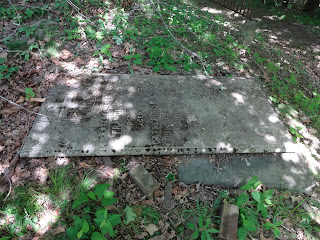Set atop a South Ridge hill that drops steeply down towards Consecration Lake, this circular lot is among the Rural's oldest plots. Surrounded by what appears to be its original iron fence, it contains a massive tree and a single gravestone. The upper part of the hill where it stands was originally called Mildand Hill on early maps of the grounds and the lower part was called Mount Formosa. As the Cemetery expanded and the maps changed, the area was renamed Oakwood Forest Hill and then Roseland Hill. Now it is simply Lot 1, Section 11.
Francis B. Dwight was born in Springfield, Massachusetts on March 14, 1808. He was the eight of twelve children born to James Scutt Dwight and Mary Sanford Dwight. He entered Harvard at sixteen and, after graduation, spent a couple of years touring Europe before studying law. He practiced in Massachusetts and the Michigan Territory before settling in New York State. On July 24, 1834, he married Catherine Van Rensselaer Schermerhorn. The first Mrs. Dwight died sometime prior to 1843 since, on April 20 of that year, he married Catherine Waters Yates.
He moved to Albany in 1840 and, with encouragement from John Canfield Spencer, the New York Secretary of State, Dwight began publication of The District School Journal For The State of New York. Though he was urged to enter politics, he preferred to "devote his life and talents to the great cause of popular education." He was named superintendent of schools for the city and county of Albany and, on June 1, 1844, was unanimously nominated to the executive committee "for the care, government, and management of the Normal School." The institution would evolve into the University At Albany, part of the State University of New York.
View of the State Normal School on the north side of State Street just below Eagle Street. Courtesy of @AlbanyMuskrat on Twitter.
City directories show Francis B. Dwight as a resident of 1 Clinton Park (now Clinton Square). While much of this block survives, his house has been demolished.
Described by one newspaper as "the most accomplished advocate of popular education" and a "pioneer" in the establishment of the Normal School, Francis Dwight died on December 15, 1845. He was only thirty-seven years old. His death, according to the Albany Argus, was caused by a serious inflammation of the bowels. He was greatly and sincerely mourned by his friends and colleagues.
Francis and his first wife share a headstone. It is a large slab laid flush to the ground near the entrance to the plot. A simple carved cross surmounts their names.
Francis' second wife survived him and remarried as she is listed in the Cemetery records as Catherine W. Graham. She was, however, interred with Francis in this lot after her death on April 4, 1879. At the time of her death, she was a resident of 168 West 47th Street in New York City. She was sixty-six years old.



No comments:
Post a Comment